TOYOTA LAND CRUISER 2019 (in English) Service Manual
Manufacturer: TOYOTA, Model Year: 2019, Model line: LAND CRUISER, Model: TOYOTA LAND CRUISER 2019Pages: 60, PDF Size: 10.01 MB
Page 41 of 60
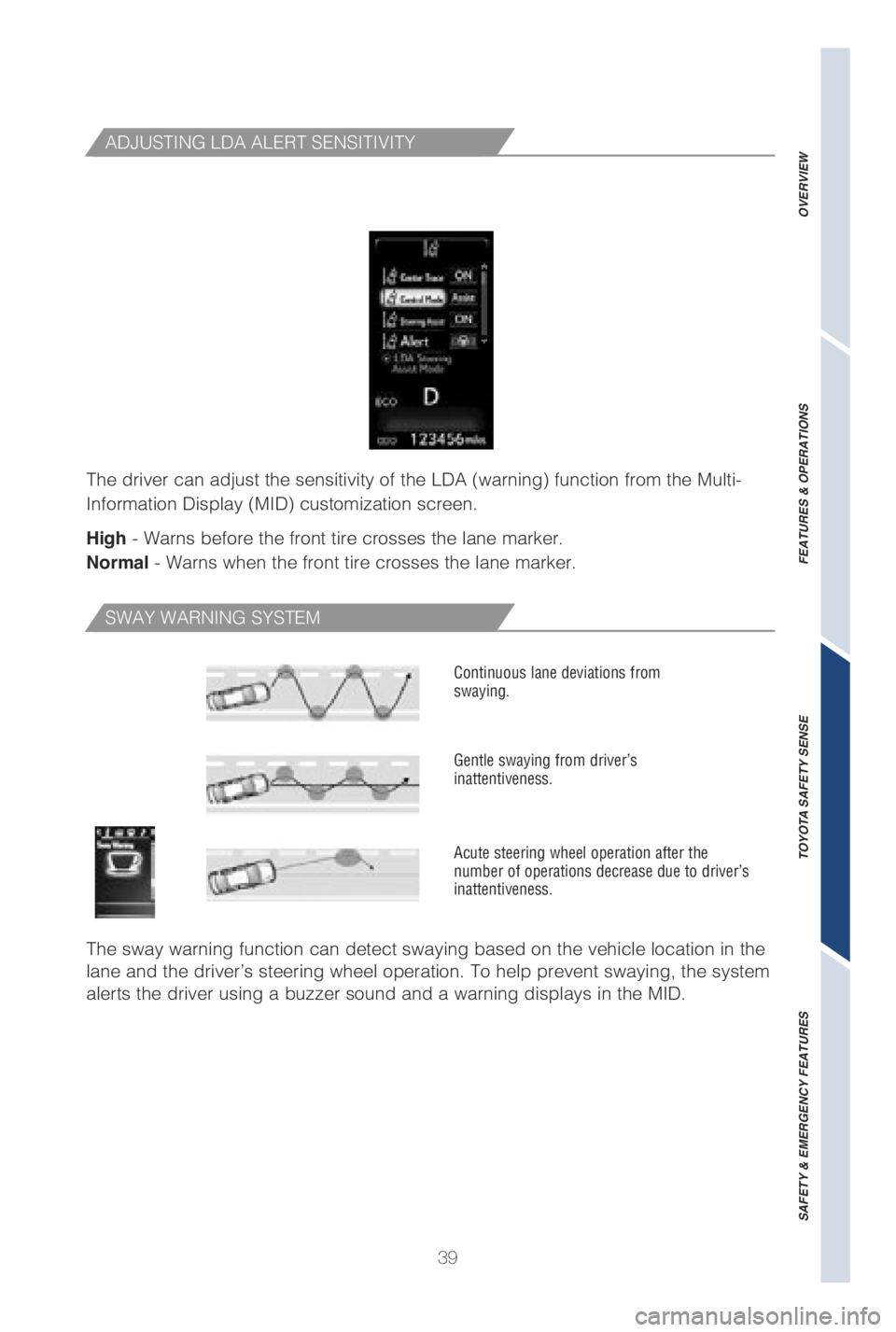
39
ADJUSTING LDA ALERT SENSITIVITY
SWAY WARNING SYSTEM
The driver can adjust the sensitivity of the LDA (warning) function from the Multi-
Information Display (MID) customization screen.
High - Warns before the front tire crosses the lane marker.
Normal - Warns when the front tire crosses the lane marker.The sway warning function can detect swaying based on the vehicle locati\
on in the
lane and the driver’s steering wheel operation. To help prevent swaying, the system
alerts the driver using a buzzer sound and a warning displays in the MID\
.
Continuous lane deviations from
swaying.
Gentle swaying from driver’s
inattentiveness.
Acute steering wheel operation after the
number of operations decrease due to driver’s
inattentiveness.
OVERVIEW
FEATURES & OPERATIONS
TOYOTA SAFETY SENSE
SAFETY & EMERGENCY FEATURES
Page 42 of 60
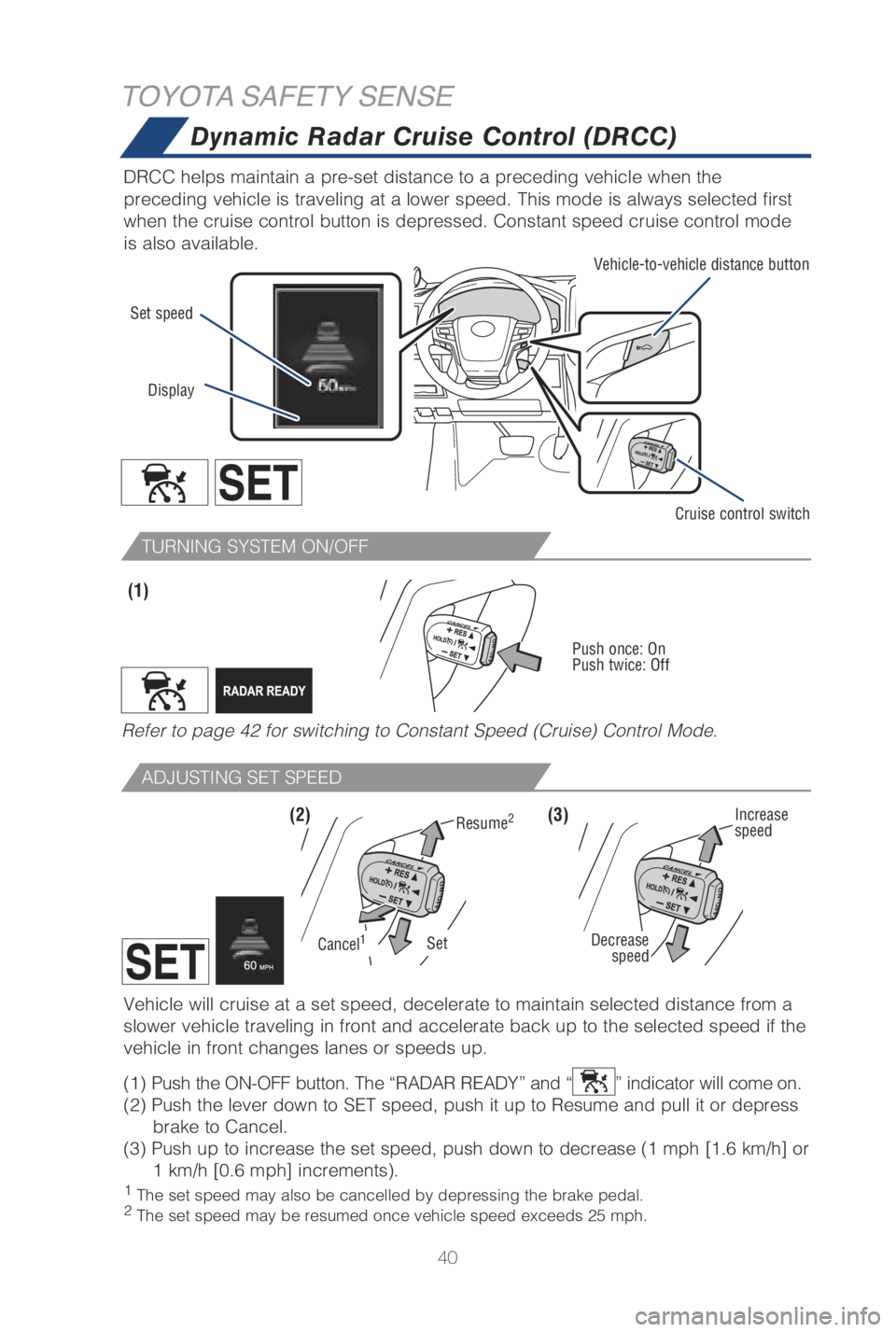
40
1 The set speed may also be cancelled by depressing the brake pedal.2 The set speed may be resumed once vehicle speed exceeds 25 mph.
DRCC helps maintain a pre-set distance to a preceding vehicle when the
preceding vehicle is traveling at a lower speed. This mode is always sel\
ected first
when the cruise control button is depressed. Constant speed cruise contr\
ol mode
is also available.
Vehicle will cruise at a set speed, decelerate to maintain selected dist\
ance from a
slower vehicle traveling in front and accelerate back up to the selected\
speed if the
vehicle in front changes lanes or speeds up.
(1) Push the ON-OFF button. The “RADAR READY” and “
” indicator will come on.
(2) Push the lever down to SET speed, push it up to Resume and pull it or depress brake to Cancel.
(3) Push up to increase the set speed, push down to decrease (1 mph [1.6 km/h] or 1 km/h [0.6 mph] increments).
(1)
Vehicle-to-vehicle distance button
Cruise control switch
Display
Set speed
Increase
speed
Decrease
speed
(3)
SetCancel1
Resume2(2)
Dynamic Radar Cruise Control (DRCC)
TOYOTA SAFETY SENSE
TURNING SYSTEM ON/OFF
ADJUSTING SET SPEED
Push once: On
Push twice: Off
Refer to page 42 for switching to Constant Speed (Cruise) Control Mode\
.
Page 43 of 60
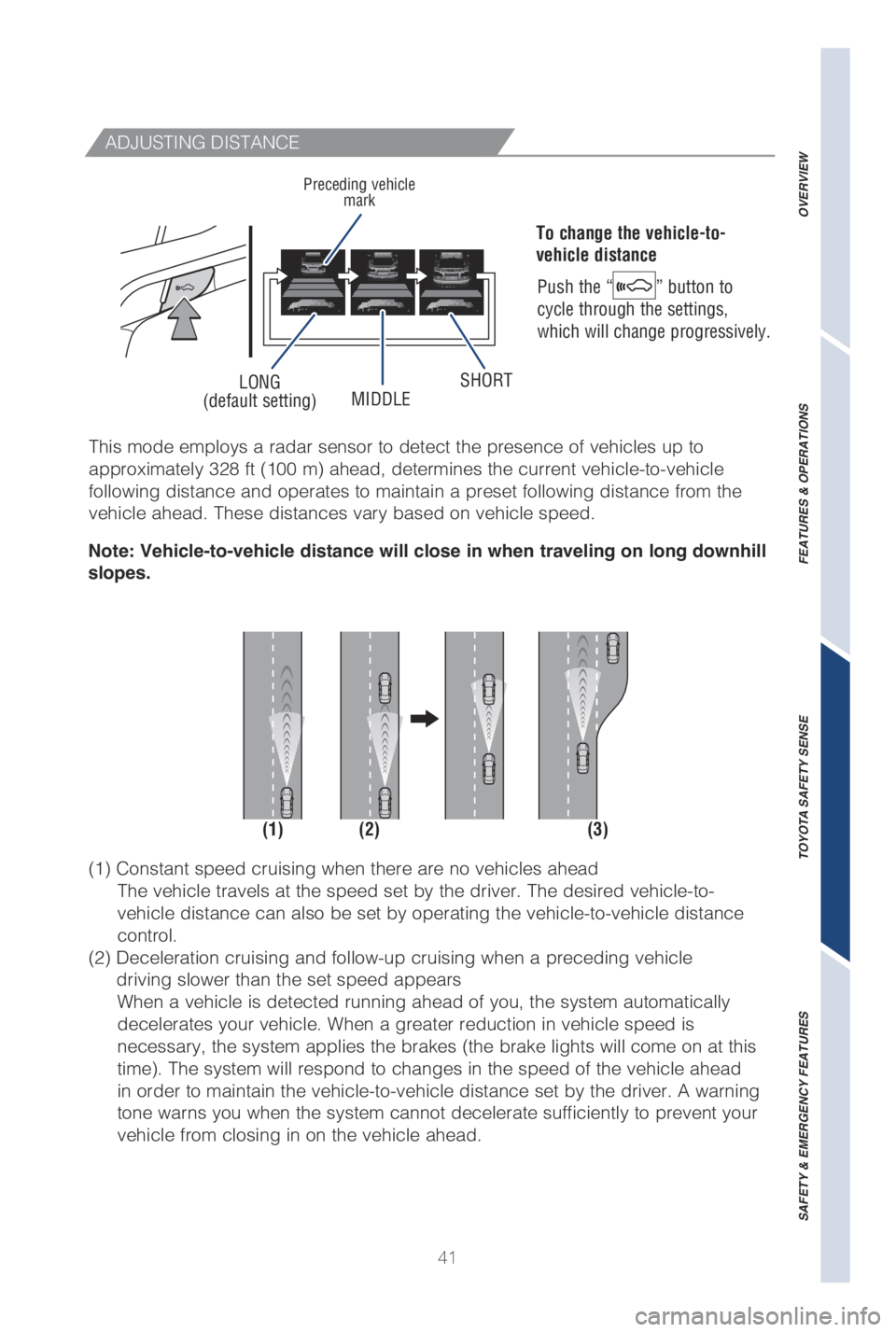
41
LONG
(default setting) MIDDLESHORT
ADJUSTING DISTANCE
To change the vehicle-to-
vehicle distance
Push the “
” button to
cycle through the settings,
which will change progressively.
Preceding vehicle mark
(1) (2) (3)
This mode employs a radar sensor to detect the presence of vehicles up t\
o
approximately 328 ft (100 m) ahead, determines the current vehicle-to-vehicle
following distance and operates to maintain a preset following distance \
from the
vehicle ahead. These distances vary based on vehicle speed.
(1) Constant speed cruising when there are no vehicles ahead
The vehicle travels at the speed set by the driver. The desired vehicle-\
to-
vehicle distance can also be set by operating the vehicle-to-vehicle dis\
tance
control.
(2) Deceleration cruising and follow-up cruising when a preceding vehicle
driving slower than the set speed appears
When a vehicle is detected running ahead of you, the system automaticall\
y
decelerates your vehicle. When a greater reduction in vehicle speed is
necessary, the system applies the brakes (the brake lights will come on at this
time). The system will respond to changes in the speed of the vehicle ahead
in order to maintain the vehicle-to-vehicle distance set by the driver. \
A warning
tone warns you when the system cannot decelerate sufficiently to prevent\
your
vehicle from closing in on the vehicle ahead.
Note: Vehicle-to-vehicle distance will close in when traveling on long downhill
slopes.
OVERVIEW
FEATURES & OPERATIONS
TOYOTA SAFETY SENSE
SAFETY & EMERGENCY FEATURES
Page 44 of 60
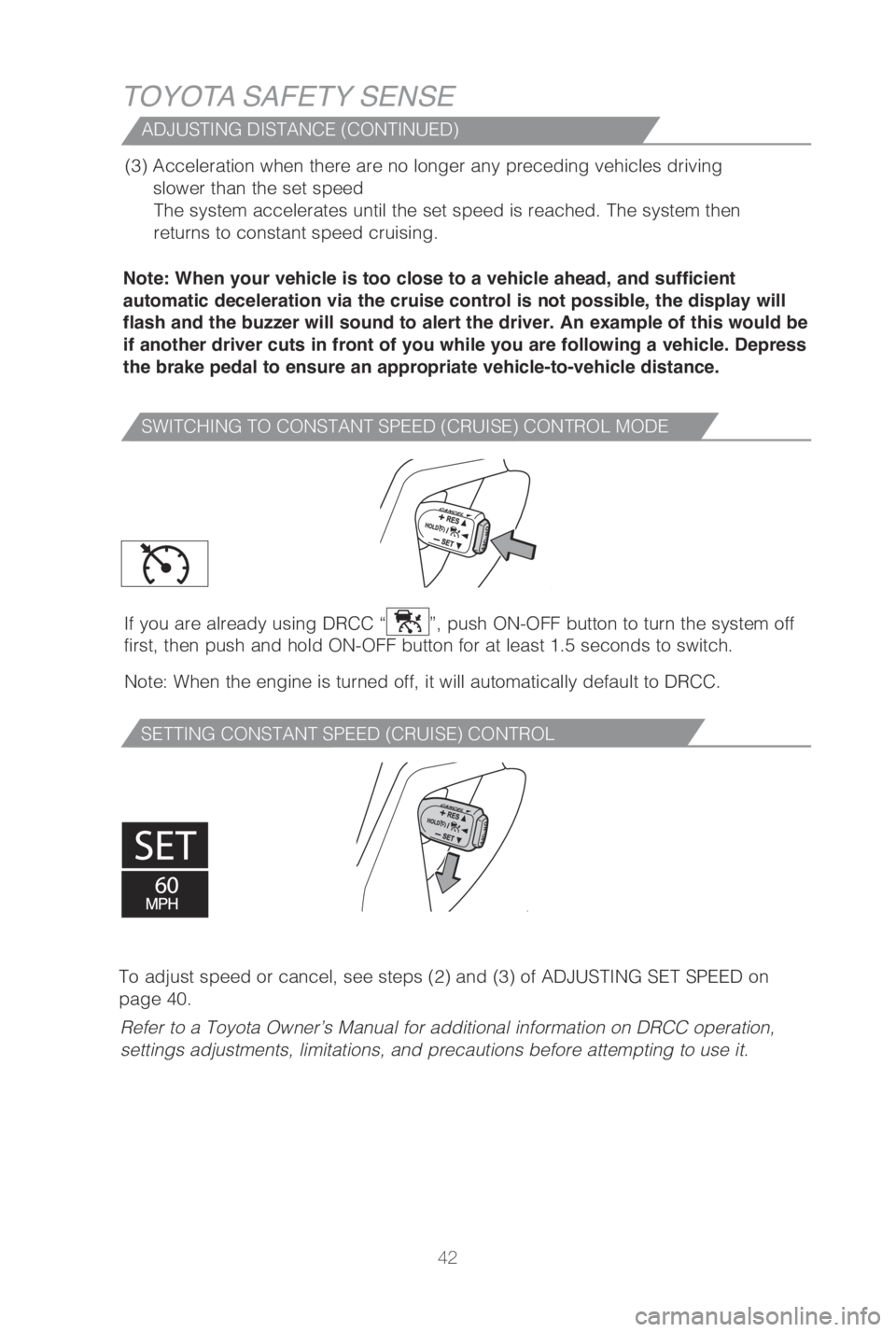
42
TOYOTA SAFETY SENSE
SWITCHING TO CONSTANT SPEED (CRUISE) CONTROL MODE
ADJUSTING DISTANCE (CONTINUED)
(3) Acceleration when there are no longer any preceding vehicles driving
slower than the set speedThe system accelerates until the set speed is reached. The system then
returns to constant speed cruising.
Note: When your vehicle is too close to a vehicle ahead, and sufficient
automatic deceleration via the cruise control is not possible, the display will
flash and the buzzer will sound to alert the driver. An example of this would be
if another driver cuts in front of you while you are following a vehicle. Depress
the brake pedal to ensure an appropriate vehicle-to-vehicle distance.
Note: When the engine is turned off, it will automatically default to DR\
CC.
If you are already using DRCC “”, push ON-OFF button to turn the system off
first, then push and hold ON-OFF button for at least 1.5 seconds to swit\
ch.
SETTING CONSTANT SPEED (CRUISE) CONTROL
Refer to a Toyota Owner’s Manual for additional information on DRCC o\
peration,
settings adjustments, limitations, and precautions before attempting to \
use it.
To adjust speed or cancel, see steps (2) and (3) of ADJUSTING SET SPEED on
page 40.
Page 45 of 60
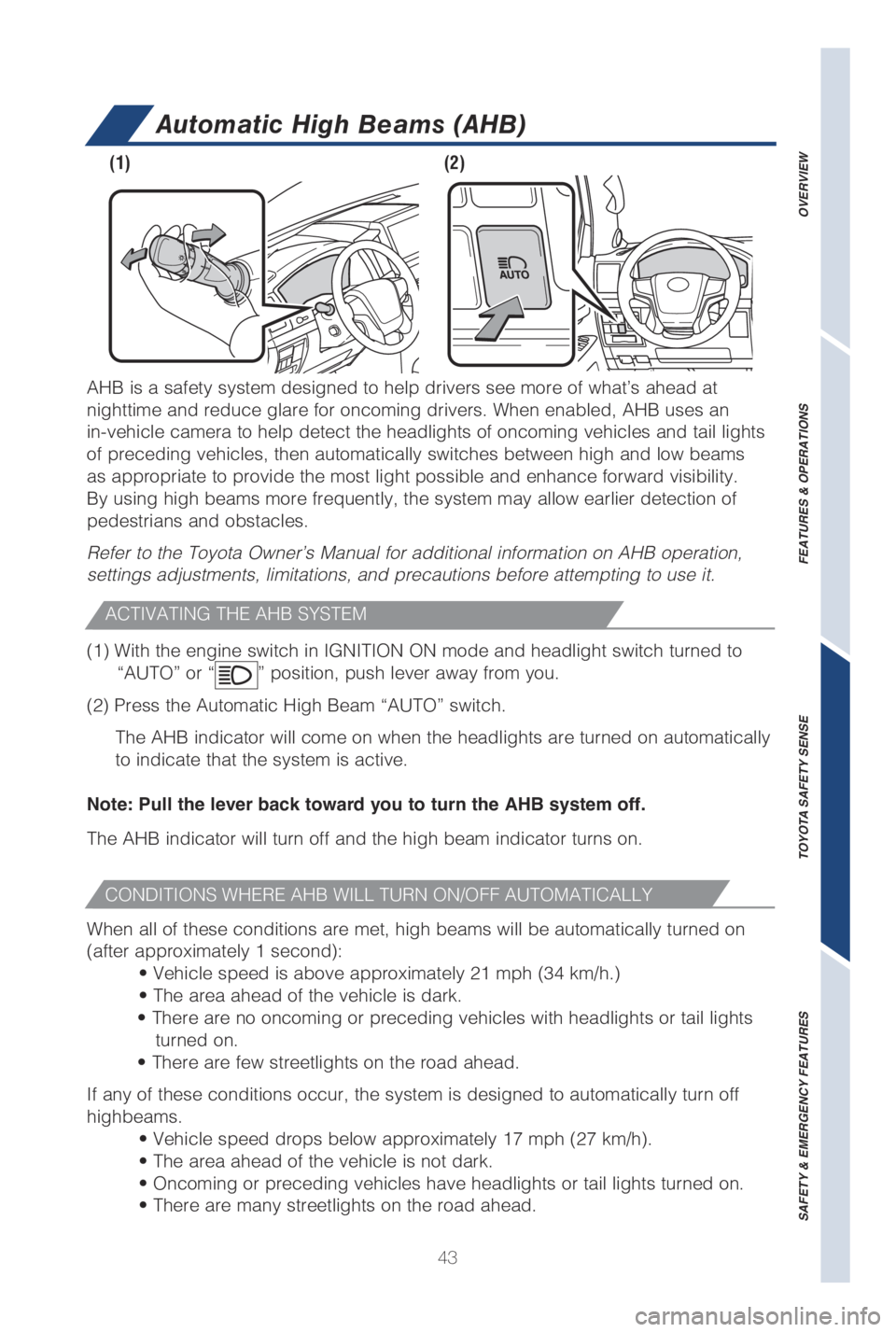
43
Automatic High Beams (AHB)
ACTIVATING THE AHB SYSTEM
CONDITIONS WHERE AHB WILL TURN ON/OFF AUTOMATICALLY
When all of these conditions are met, high beams will be automatically t\
urned on
(after approximately 1 second):• Vehicle speed is above approximately 21 mph (34 km/h.)
• The area ahead of the vehicle is dark.
• There are no oncoming or preceding vehicles with headlights or tail\
lights turned on.
• There are few streetlights on the road ahead.
If any of these conditions occur, the system is designed to automaticall\
y turn off
highbeams. • Vehicle speed drops below approximately 17 mph (27 km/h).
• The area ahead of the vehicle is not dark.
• Oncoming or preceding vehicles have headlights or tail lights turne\
d on.
• There are many streetlights on the road ahead.
(1) With the engine switch in IGNITION ON mode and headlight switch turned to
“AUTO” or “” position, push lever away from you.
(2) Press the Automatic High Beam “AUTO” switch. The AHB indicator will come on when the headlights are turned on automat\
ically
to indicate that the system is active.
Note: Pull the lever back toward you to turn the AHB system off.
The AHB indicator will turn off and the high beam indicator turns on.
OVERVIEW
FEATURES & OPERATIONS
TOYOTA SAFETY SENSE
SAFETY & EMERGENCY FEATURES
AHB is a safety system designed to help drivers see more of what’s ahead at
nighttime and reduce glare for oncoming drivers. When enabled, AHB uses \
an
in-vehicle camera to help detect the headlights of oncoming vehicles and\
tail lights
of preceding vehicles, then automatically switches between high and low \
beams
as appropriate to provide the most light possible and enhance forward vi\
sibility.
By using high beams more frequently, the system may allow earlier detect\
ion of
pedestrians and obstacles.
Refer to the Toyota Owner’s Manual for additional information on AHB \
operation,
settings adjustments, limitations, and precautions before attempting to \
use it. (1)
(2)
Page 46 of 60
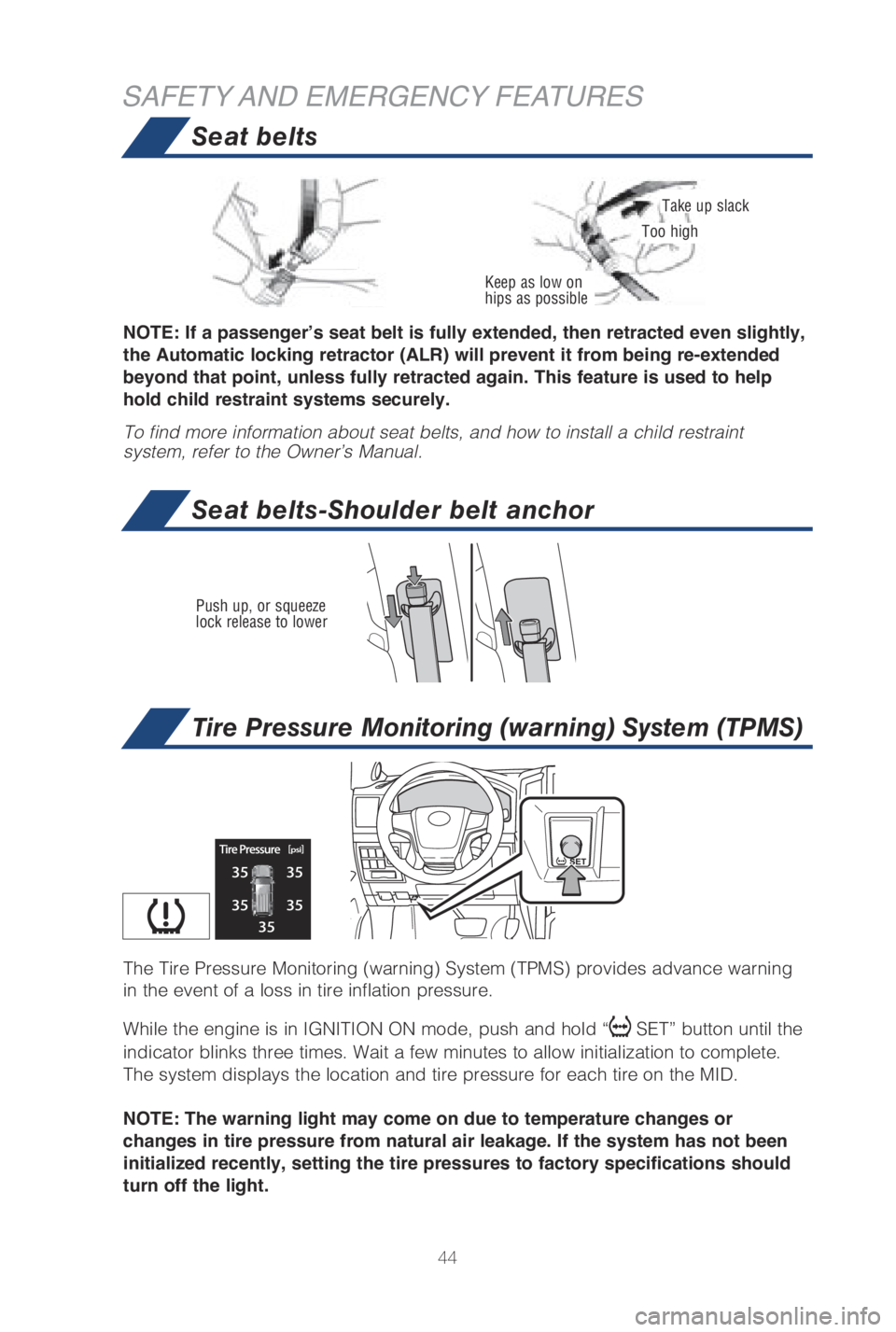
44
NOTE: If a passenger’s seat belt is fully extended, then retracted even slightly,
the Automatic locking retractor (ALR) will prevent it from being re-extended
beyond that point, unless fully retracted again. This feature is used to help
hold child restraint systems securely.
To find more information about seat belts, and how to install a child re\
straint
system, refer to the Owner’s Manual.
Keep as low on
hips as possible
Take up slack
Too high
Push up, or squeeze
lock release to lower
The Tire Pressure Monitoring (warning) System (TPMS) provides advance warning
in the event of a loss in tire inflation pressure.
While the engine is in IGNITION ON mode,
push and hold “
SET” button until the
indicator blinks three times. Wait a few minutes to allow initialization\
to complete.
The system displays the location and tire pressure for each tire on the \
MID.
NOTE: The warning light may come on due to temperature changes or
changes in tire pressure from natural air leakage. If the system has not been
initialized recently, setting the tire pressures to factory specifications should
turn off the light.
Seat belts
Seat belts-Shoulder belt anchor
Tire Pressure Monitoring (warning) System (TPMS)
SAFETY AND EMERGENCY FEATURES
Page 47 of 60
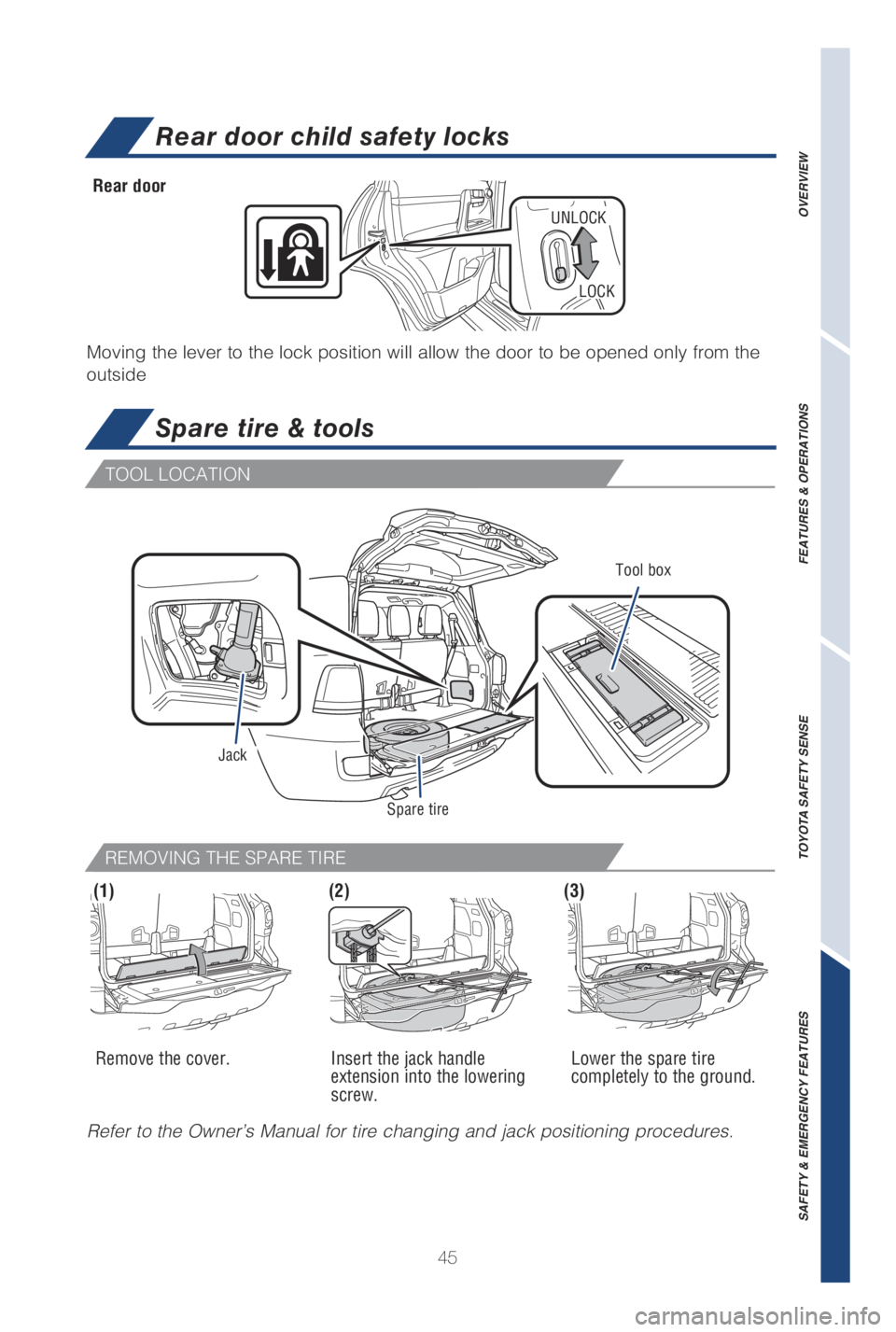
45
OVERVIEW
FEATURES & OPERATIONS
TOYOTA SAFETY SENSE
SAFETY & EMERGENCY FEATURES
Rear door child safety locks
Spare tire & tools
Refer to the Owner’s Manual for tire changing and jack positioning procedures.
Remove the cover.
Insert the jack handle
extension into the lowering
screw. Lower the spare tire
completely to the ground.
Spare tire
Moving the lever to the lock position will allow the door to be opened o\
nly from the
outside
Rear door
Jack Tool box
(1)(2)(3)
TOOL LOCATION
REMOVING THE SPARE TIRE
UNLOCK
LOCK
Page 48 of 60
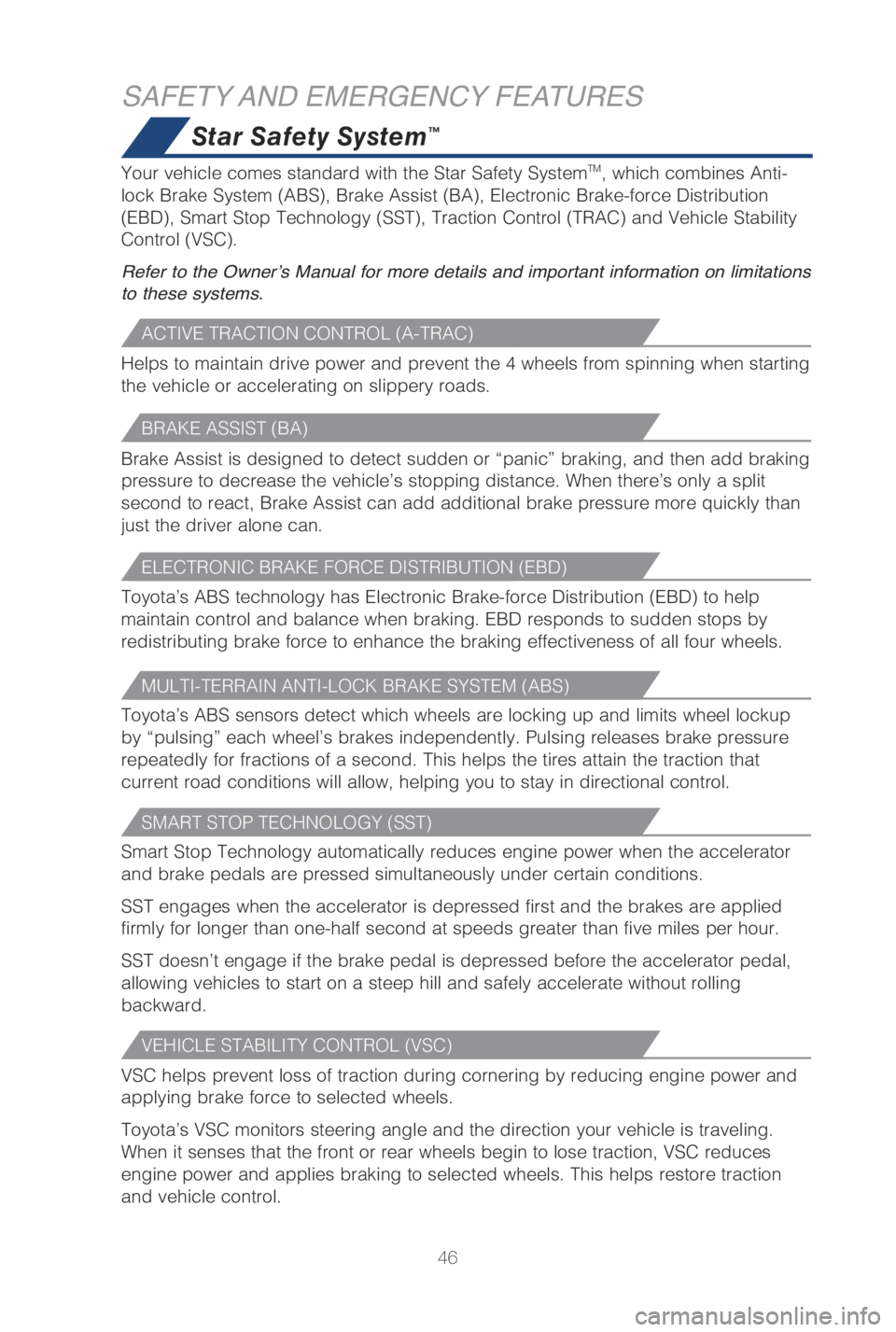
46
Star Safety System™
SAFETY AND EMERGENCY FEATURES
Your vehicle comes standard with the Star Safety SystemTM, which combines Anti-
lock Brake System (ABS), Brake Assist (BA), Electronic Brake-force Distribution
(EBD), Smart Stop Technology (SST), Traction Control (TRAC) and Vehicle Stability
Control (VSC).
Refer to the Owner’s Manual for more details and important information on limitations
to these systems.
VSC helps prevent loss of traction during cornering by reducing engine p\
ower and
applying brake force to selected wheels.
Toyota’s VSC monitors steering angle and the direction your vehicle is traveling.
When it senses that the front or rear wheels begin to lose traction, VSC\
reduces
engine power and applies braking to selected wheels. This helps restore \
traction
and vehicle control.
VEHICLE STABILITY CONTROL (VSC)
Helps to maintain drive power and prevent the 4 wheels from spinning whe\
n starting
the vehicle or accelerating on slippery roads.
ACTIVE TRACTION CONTROL (A-TRAC)
Toyota’s ABS sensors detect which wheels are locking up and limits wheel lockup
by “pulsing” each wheel’s brakes independently. Pulsing releases brake pressure
repeatedly for fractions of a second. This helps the tires attain the tr\
action that
current road conditions will allow, helping you to stay in directional c\
ontrol.
MULTI-TERRAIN ANTI-LOCK BRAKE SYSTEM (ABS)
Toyota’s ABS technology has Electronic Brake-force Distribution (EBD) to help
maintain control and balance when braking. EBD responds to sudden stops \
by
redistributing brake force to enhance the braking effectiveness of all f\
our wheels.
ELECTRONIC BRAKE FORCE DISTRIBUTION (EBD)
Brake Assist is designed to detect sudden or “panic” braking, and \
then add braking
pressure to decrease the vehicle’s stopping distance. When there’s only a split
second to react, Brake Assist can add additional brake pressure more qui\
ckly than
just the driver alone can.
BRAKE ASSIST (BA)
Smart Stop Technology automatically reduces engine power when the accele\
rator
and brake pedals are pressed simultaneously under certain conditions.
SST engages when the accelerator is depressed first and the brakes are a\
pplied
firmly for longer than one-half second at speeds greater than five miles\
per hour.
SST doesn’t engage if the brake pedal is depressed before the accelerator pedal,
allowing vehicles to start on a steep hill and safely accelerate without\
rolling
backward.
SMART STOP TECHNOLOGY (SST)
Page 49 of 60
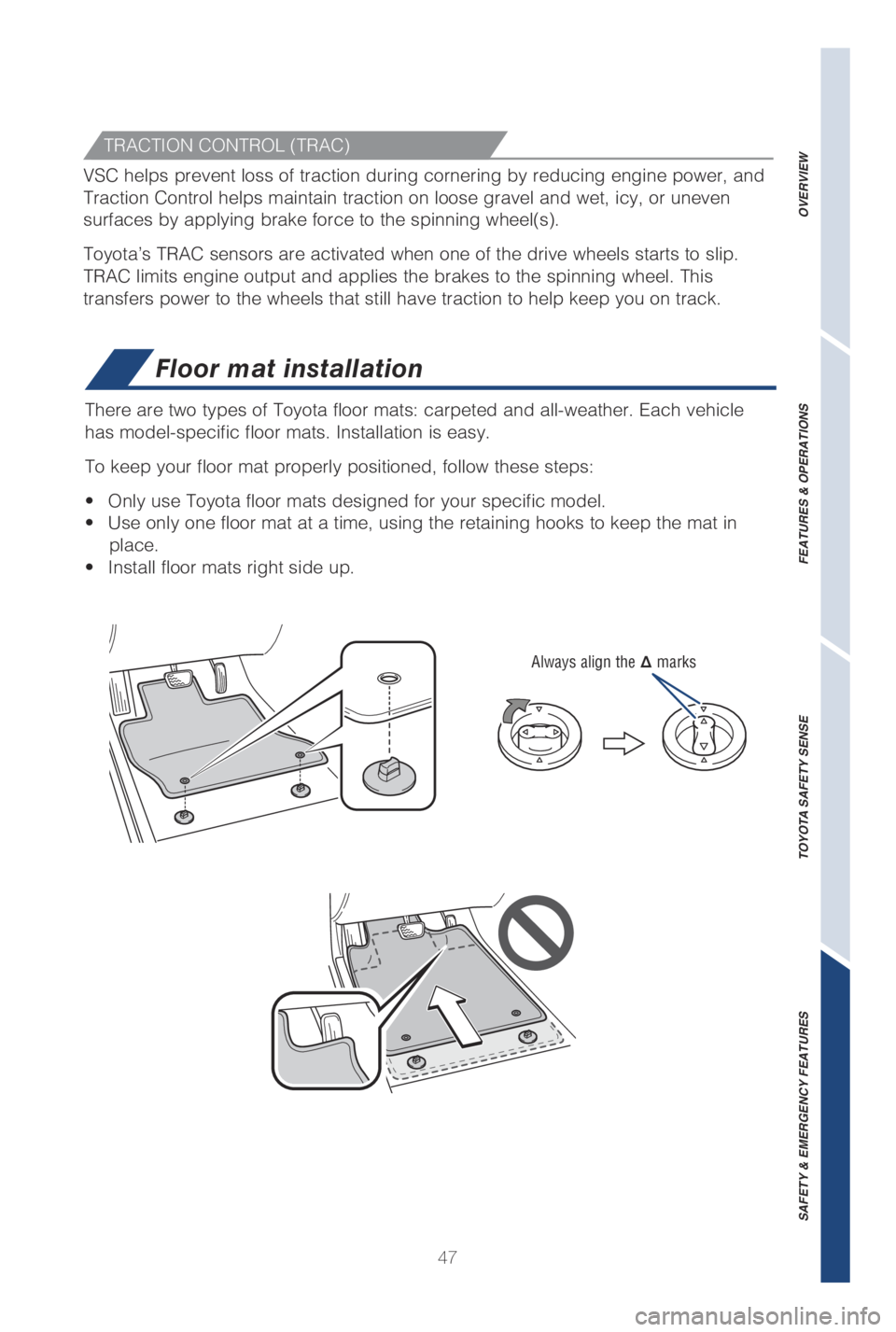
47
Floor mat installation
There are two types of Toyota floor mats: carpeted and all-weather. Each\
vehicle
has model-specific floor mats. Installation is easy.
To keep your floor mat properly positioned, follow these steps:
• Only use Toyota floor mats designed for your specific model.
• Use only one floor mat at a time, using the retaining hooks to keep the \
mat in
place.
• Install floor mats right side up.
Always align the Δ marks
TRACTION CONTROL (TRAC)
VSC helps prevent loss of traction during cornering by reducing engine p\
ower, and
Traction Control helps maintain traction on loose gravel and wet, icy, o\
r uneven
surfaces by applying brake force to the spinning wheel(s).
Toyota’s TRAC sensors are activated when one of the drive wheels starts to slip.
TRAC limits engine output and applies the brakes to the spinning wheel. \
This
transfers power to the wheels that still have traction to help keep you \
on track.
OVERVIEW
FEATURES & OPERATIONS
TOYOTA SAFETY SENSE
SAFETY & EMERGENCY FEATURES
Page 50 of 60
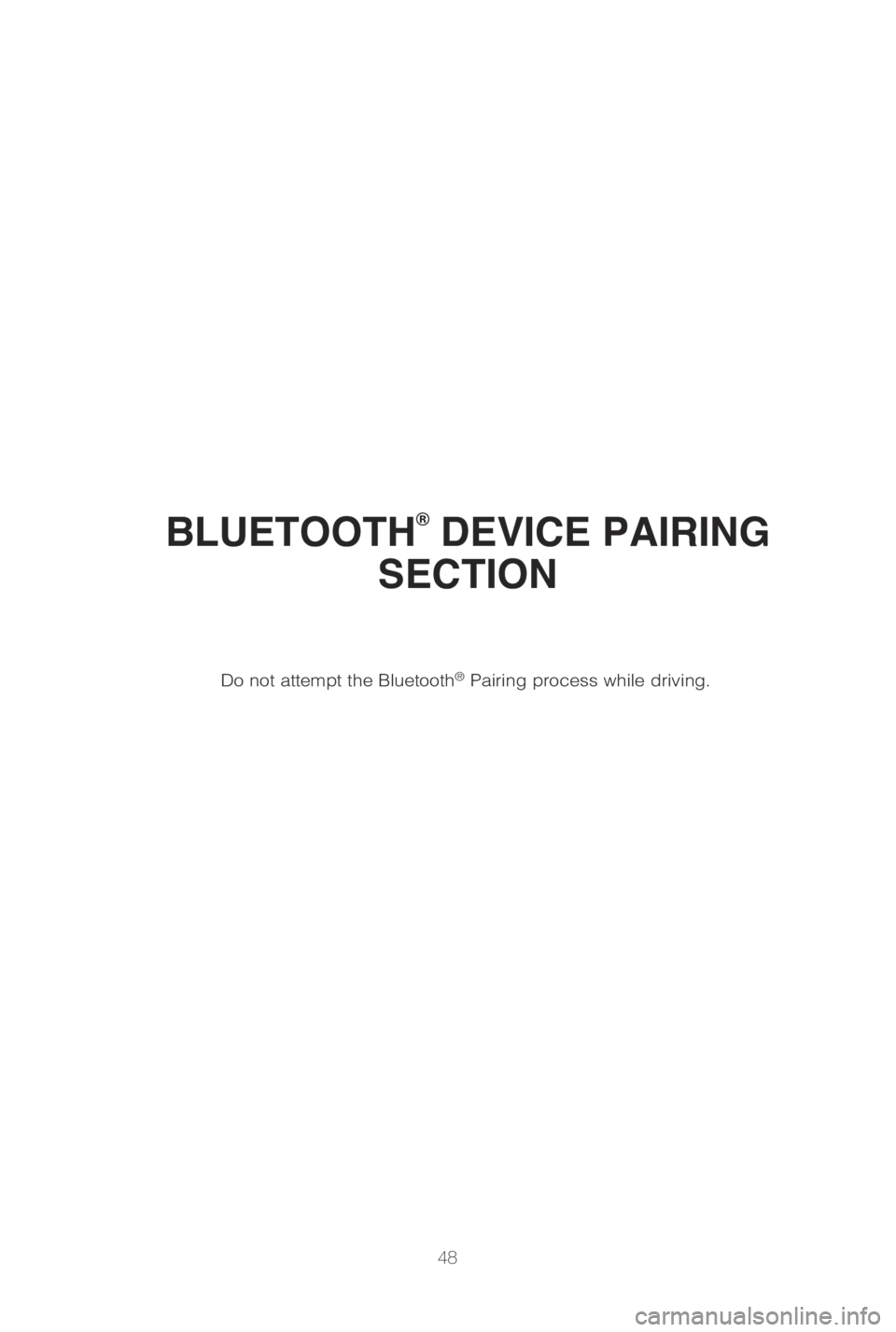
48
BLUETOOTH® DEVICE PAIRING
SECTION
Do not attempt the Bluetooth® Pairing process while driving.